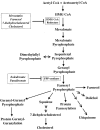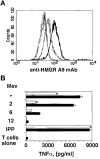Human T cell receptor gammadelta cells recognize endogenous mevalonate metabolites in tumor cells
- PMID: 12538656
- PMCID: PMC2193814
- DOI: 10.1084/jem.20021500
Human T cell receptor gammadelta cells recognize endogenous mevalonate metabolites in tumor cells
Abstract
T lymphocytes expressing the T cell receptor (TCR)-gammadelta recognize unknown antigens on tumor cells. Here we identify metabolites of the mevalonate pathway as the tumor ligands that activate TCR-gammadelta cells. In tumor cells, blockade of hydroxy-methylglutaryl-CoA reductase (HMGR), the rate limiting enzyme of the mevalonate pathway, prevents both accumulation of mevalonate metabolites and recognition by TCR-gammadelta cells. When metabolite accumulation is induced by overexpressing HMGR or by treatment with nitrogen-containing bisphosphonate drugs, tumor cells derived from many tissues acquire the capacity to stimulate the same TCR-gammadelta population. Accumulation of mevalonate metabolites in tumor cells is a powerful danger signal that activates the immune response and may represent a novel target of tumor immunotherapy.
Figures





References
-
- Porcelli, S., M.B. Brenner, and H. Band. 1991. Biology of the human γδ T-cell receptor. Immunol. Rev. 120:137–183. - PubMed
-
- Burk, M.R., L. Mori, and G. De Libero. 1995. Human V gamma 9-V delta 2 cells are stimulated in a cross-reactive fashion by a variety of phosphorylated metabolites. Eur. J. Immunol. 25:2052–2058. - PubMed
-
- Tanaka, Y., C.T. Morita, Y. Tanaka, E. Nieves, M.B. Brenner, and B.R. Bloom. 1995. Natural and synthetic non-peptide antigens recognized by human gamma delta T cells. Nature. 375:155–158. - PubMed
-
- Belmant, C., E. Espinosa, R. Poupot, M.A. Peyrat, M. Guiraud, Y. Poquet, M. Bonneville, and J.J. Fournie. 1999. 3-Formyl-1-butyl pyrophosphate A novel mycobacterial metabolite-activating human gammadelta T cells. J. Biol. Chem. 274:32079–32084. - PubMed
-
- Feurle, J., E. Espinosa, S. Eckstein, F. Pont, V. Kunzmann, J.J. Fournie, M. Herderich, and M. Wilhelm. 2002. Escherichia coli produces phosphoantigens activating human gamma delta T cells. J. Biol. Chem. 277:148–154. - PubMed
Publication types
MeSH terms
Substances
LinkOut - more resources
Full Text Sources
Other Literature Sources

